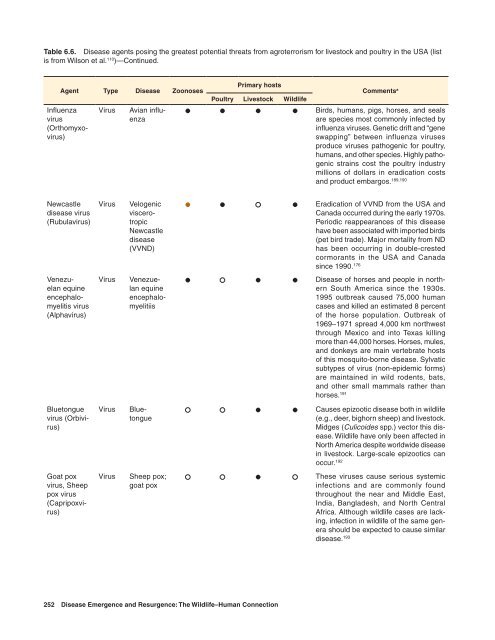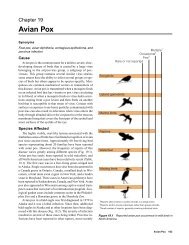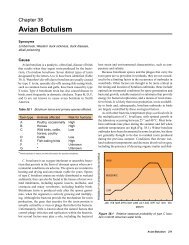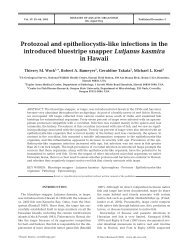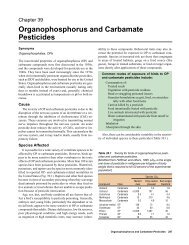Biowarfare, Bioterrorism, and Animal Diseases as Bioweapons
Biowarfare, Bioterrorism, and Animal Diseases as Bioweapons
Biowarfare, Bioterrorism, and Animal Diseases as Bioweapons
Create successful ePaper yourself
Turn your PDF publications into a flip-book with our unique Google optimized e-Paper software.
Table 6.6. Dise<strong>as</strong>e agents posing the greatest potential threats from agroterrorism for livestock <strong>and</strong> poultry in the USA (list<br />
is from Wilson et al. 110 )—Continued.<br />
Agent Type Dise<strong>as</strong>e Zoonoses<br />
Influenza<br />
virus<br />
(Orthomyxovirus)<br />
Newc<strong>as</strong>tle<br />
dise<strong>as</strong>e virus<br />
(Rubulavirus)<br />
Venezuelan<br />
equine<br />
encephalomyelitis<br />
virus<br />
(Alphavirus)<br />
Bluetongue<br />
virus (Orbivirus)<br />
Goat pox<br />
virus, Sheep<br />
pox virus<br />
(Capripoxvirus)<br />
Virus Avian influenza<br />
Virus Velogenic<br />
viscerotropic<br />
Newc<strong>as</strong>tle<br />
dise<strong>as</strong>e<br />
(VVND)<br />
Virus Venezuelan<br />
equine<br />
encephalomyelitiis<br />
Virus Bluetongue<br />
Virus Sheep pox;<br />
goat pox<br />
Primary hosts<br />
Poultry Livestock Wildlife<br />
252 Dise<strong>as</strong>e Emergence <strong>and</strong> Resurgence: The Wildlife–Human Connection<br />
Comments a<br />
● ● ● ● Birds, humans, pigs, horses, <strong>and</strong> seals<br />
are species most commonly infected by<br />
influenza viruses. Genetic drift <strong>and</strong> “gene<br />
swapping” between influenza viruses<br />
produce viruses pathogenic for poultry,<br />
humans, <strong>and</strong> other species. Highly pathogenic<br />
strains cost the poultry industry<br />
millions of dollars in eradication costs<br />
<strong>and</strong> product embargos. 189,190<br />
● ● ● Eradication of VVND from the USA <strong>and</strong><br />
Canada occurred during the early 1970s.<br />
Periodic reappearances of this dise<strong>as</strong>e<br />
have been <strong>as</strong>sociated with imported birds<br />
(pet bird trade). Major mortality from ND<br />
h<strong>as</strong> been occurring in double-crested<br />
cormorants in the USA <strong>and</strong> Canada<br />
since 1990. 176<br />
● ● ● Dise<strong>as</strong>e of horses <strong>and</strong> people in northern<br />
South America since the 1930s.<br />
1995 outbreak caused 75,000 human<br />
c<strong>as</strong>es <strong>and</strong> killed an estimated 8 percent<br />
of the horse population. Outbreak of<br />
1969–1971 spread 4,000 km northwest<br />
through Mexico <strong>and</strong> into Tex<strong>as</strong> killing<br />
more than 44,000 horses. Horses, mules,<br />
<strong>and</strong> donkeys are main vertebrate hosts<br />
of this mosquito-borne dise<strong>as</strong>e. Sylvatic<br />
subtypes of virus (non-epidemic forms)<br />
are maintained in wild rodents, bats,<br />
<strong>and</strong> other small mammals rather than<br />
horses. 191<br />
● ● Causes epizootic dise<strong>as</strong>e both in wildlife<br />
(e.g., deer, bighorn sheep) <strong>and</strong> livestock.<br />
Midges (Culicoides spp.) vector this dise<strong>as</strong>e.<br />
Wildlife have only been affected in<br />
North America despite worldwide dise<strong>as</strong>e<br />
in livestock. Large-scale epizootics can<br />
occur. 192<br />
● These viruses cause serious systemic<br />
infections <strong>and</strong> are commonly found<br />
throughout the near <strong>and</strong> Middle E<strong>as</strong>t,<br />
India, Bangladesh, <strong>and</strong> North Central<br />
Africa. Although wildlife c<strong>as</strong>es are lacking,<br />
infection in wildlife of the same genera<br />
should be expected to cause similar<br />
dise<strong>as</strong>e. 193


